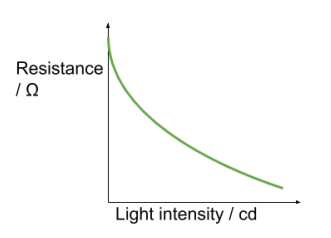Electric circuits-topic 3 physics
1/49
There's no tags or description
Looks like no tags are added yet.
Name | Mastery | Learn | Test | Matching | Spaced |
|---|
No study sessions yet.
50 Terms
Electric current equation
I=Q/T where Q is change in charge and t is change in time
Electric current
the rate of flow of charged particles, or the for of charge per unit time
Potential difference
The energy transferred per unit charge between two points in a circuit
Potential difference equation
V=W/Q where W is the energy transferred and Q is the charge
Resistance
the measure of how difficult it is for charge carriers to pass through a component
Resistance equation
R=V/I
What does Ohm’s law state?
for an ohmic conductor, current is directly proportional to the potential difference across it, given that physical conditions are kept constant
principle of charge conservation
states that the total electric charge in a closed system does not change.
Kirchoff’s first law
The total current flowing into a junction is equal to the current flowing out of that junction. It is an application of the principal of charge conservation
Current in a series circuit and why
the current is the same everywhere because of kirchoff’s law
Current in parallel and why
The sum of the currents in each parallel set of branches is equal to the total current because of Kirchoff’s first law
Principle of conservation of energy
states that energy cannot be created or destroyed, but can be transferred from one form to another. Therefore, the total energy in a closed system stays constant
Potential difference in series and why
the batter Potential difference is shared across all elements in the circuit, therefore the total sum of the voltages across all elements is equal to the supply potential difference. This is because of energy conservation
Potential difference in parallel and why
The potential difference across each branch is the same
Kirchoff’s second law
The sum of all voltages in a series circuit is equal to the battery voltage or the sum of all the voltages in a loop is zero
Resistance in a series circuit equation and derivative
Rt=R1+R2+R3+…Rn
Using Ohm’s law, you can calculate the voltage voltage of each one e.g. Vn=IRn Then you can apply Kirchoff’s second law
Resistance in parallel and derivative
1/Rt=1/R1+1/R2+…1/Rn Due to Kirchoff’s second law, you know that the potential difference across each resistor is the same as the supply voltage so In=V/Rn
Power
the energy transferred over time or rate of transfer of energy.
Power equation
P=IV
Energy transferred equation
W=VIt
Ohmic conductor current-voltage graphs
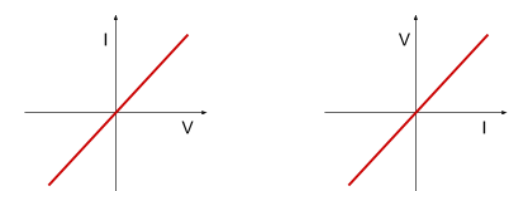
Semiconductor diode current-voltage graph
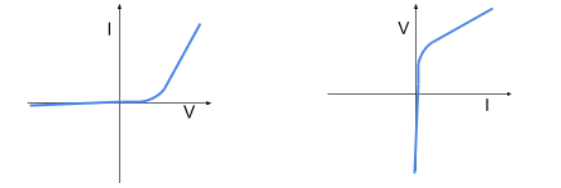
Reason for ohmic conductors current voltage graph
it follows Ohm’s law therefore its current-voltage graphs look like a straight line through the origin
Reason for semiconductor diode’s current-voltage graphs
The forward bias of a diode is the direction in which it will allow current to flow easily past the threshold voltage, which is the smallest voltage needed to allow current to flow. In the direction of the reverse bias, the resistance of the diode is extremely high meaning that only a few small current can flow
Filament bulbs current-voltage graphs

Reason for Filament bulbs current-voltage graphs
The component contains a length of metal wire, which heats up as current increases, therefore the resistance of this component increases as current increases. At low currents the metal wire will not heat up significantly, therefore for very low currents, Ohm’s law is obeyed. However as the current increases, the graph begins to curve due to the increasing resistance
(Negative Temperature Coefficient) thermistor current-voltage graphs
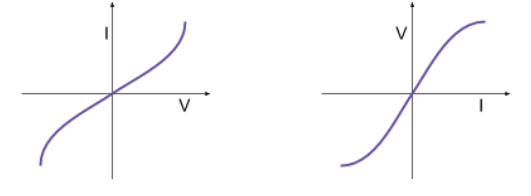
(Negative Temperature Coefficient) thermistor current-voltage graphs reasoning
This component acts in the opposite way to a filament bulb because as it heats up (due to an increase in current), the resistance across it will decrease. This is because increasing the temperature of a thermistor causes electrons to be emitted from atoms, therefore the number of charge carriers increases and so current increases causing resistance to decrease. Similarly to a filament bulb, at low currents, where temperature is kept constant, Ohm’s law is obeyed.
Resistivity (p)
a measure of how easily a material conducts electricity. It is given the value of resistance through a material of length 1m and cross-sectional area 1m².
Resistivity (p) equation
p=RA/l
Current
the rate of flow of charged particles
Charge carrier density (n)
describes the number of charge carriers a material contains per unit volume
Drift velocity
the average speed at which charger particles move along a conductor
electrons charge
1.6×10^-19
Current passing through a conductor equation
I=nqvA where n= charge carrier density, q= charge of charge carrier, v=drift velocity and A is cross sectional area
Why is there a large range of resistivities of different materials?
Different materials have different values of charge carrier density and even the same material has different values for different temperature. This is because, when a material is given more energy, some of its atoms may release more charge carriers, increasing the charge carrier density
Potential along a uniform current-carrying wire
it increases uniformly with the distance along the wire because of Ohm’s law
What is a potential divider?
a circuit with several resistor in series connected across a voltage source, used to produce a required fraction of the source potential difference, which remains constant
What causes an internal resistance?
electrons colliding with atoms inside a battery
Electromotive force
the energy transferred by a cell per coulomb of charge
Electromotive force equation
e=E/Q where E is energy transferred and Q is charge
Why does resistance increase in a material?
Most solids are arranged in a crystal lattice structure. This provides a medium for vibration of the atoms about their equilibrium position. As the temperature of the solid increases, the intensity of vibration of its atoms also increases. The more intense that the lattice vibrations of atoms in a material are, the more difficult it is for free electrons to pass through it. This is because the electrons will be more likely to collide with the vibrating atoms , causing them to slow down.
Why does resistance decrease in a material?
As the temperature of a metal or semiconductor increases, its atoms gain energy, once they gain enough energy they begin to release electrons (this is known as thermionic emission). This increases the number of charge carriers available in the conductor, which decreases its resistance
Negative temperature coefficient thermistors
designed in such a way that as their temperature increases, their resistance decreases. This occurs because they release a large amount of charge carriers as their temperature increases
Temperature-resistance graph of a negative temperature coefficient thermistors
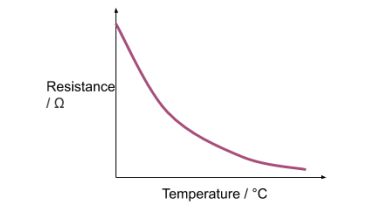
Metallic conductors
as their temperature increases, their resistance also increases due to lattice vibrations in the conductor becoming more intense. More electrons are also released but not quickly enough to counter the disruptive effect of the lattice vibrations
temperature-resistance graph of a metallic conductor

Photoelectric effect
When light above a certain frequency is shone onto a metal, it releases electrons, which are known as photoelectrons
Light-dependant resistors ((LDRs)
made from photoconductive materials, meaning that they release electrons in the presence of light, as described above. Therefore, as light intensity increases, electrons are released, which increases the number of charge carriers available to conduct electricity, and the resistance of the LDR decreases.
resistance-light intensity graph for an LDR
